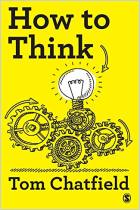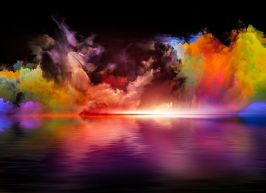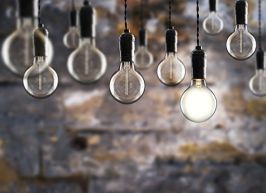Join getAbstract to access the summary!

Join getAbstract to access the summary!
Anna Abraham
The Creative Brain
Myths and Truths
MIT Press, 2024
What's inside?
Creativity researcher Anna Abraham explores and debunks popular myths concerning creativity.
Recommendation
Is the right brain hemisphere responsible for creativity? Are people with high IQs more creative? What’s the relationship between creativity and madness? In this engaging text, creativity researcher Anna Abraham explains the source of erroneous beliefs about creativity and why people embrace them so readily. By digging into the empirical evidence, Abraham brings to life the nuanced “kernel of truths” that hide within popular myths about creativity. Her exploration offers valuable guidance to readers looking to understand what may — or may not — affect their creative capacity.
Take-Aways
- The brain’s right hemisphere isn’t the sole seat of creativity.
- Madness doesn’t universally lead to creativity.
- Psychedelics don’t immediately improve creativity.
- Atypical brains don’t always support heightened creativity.
- A high IQ doesn’t necessarily lead to a high degree of creativity.
- Dopamine isn’t directly associated with creativity.
- The Default Mode Network (DMN) isn’t solely responsible for creativity.
Summary
The brain’s right hemisphere isn’t the sole seat of creativity.
Creativity is not confined to one brain hemisphere. The myth of the creative right brain began in the 19th century when scientists discovered the left hemisphere’s crucial role in language and intentional movement and associated it with intelligence and reason.Science associated the right hemisphere with opposite processes — instinct and madness.
In the mid-20th century, studies on “split-brain patients” — those who had the central communication point between both hemispheres, the corpus callosum, cut as a treatment for epilepsy — seemed to show both hemispheres operating independently. Tests demonstrated that the left brain directs spoken and written communication. However, many conclusions about the right brain’s functions were more speculative — extrapolated from findings about the left brain. Nevertheless, the idea that the right brain served as the locus of human creativity soon spread widely. By the 1970s, the notion that each side of the brain controlled different functions influenced business, education, and self-help.
“The seat of creativity is not limited to any one hemisphere. Creativity, by its very nature, demands an expansive throne.”
The notion that the right and left brain functions are starkly different persists in popular culture today. However, as modern neuroscientific evidence shows, the brain’s right hemisphere isn’t solely responsible for creativity, and the left hemisphere doesn’t exclusively handle logic and language. Both hemispheres interact dynamically to produce creative thought.The right hemisphere is more involved in the “aha” moments of initial creative insight; the left is involved in expanding concepts to create new ideas.
Madness doesn’t universally lead to creativity.
Madness — in the sense of mental illness — is not empirically linked with creativity. Society tends to embrace the notion that artists are, by nature, afflicted by a kind of madness in some time periods and reject it in others. People promoted the idea of the irrational, “tortured genius” in concert with the creativity of 18th-century British poets and late-20th-century American writers. And yet, no one associated the great creative minds of the Italian Renaissance — from the 14th to the 16th century — with cognitive or emotional dysfunction.
“Not all who are mad are creative, and not all who are creative are mad.”
These disparities show madness is not a necessary feature of creativity. They also highlight important questions about how environmental factors, such as social and financial support for art, play in whether creators develop mental illnesses. For example, Census data from 2012 to 2016 showed that 34% of artists in the United States were self-employed — compared to 9% of the non-artistic population. Those working as artists also earned lower incomes than their similarly educated peers. Add in economic instability, the fact creative ideas don’t show up on demand, and that public reception of an artist’s work is largely out of the artist’s control, and it’s easy to see how stress might contribute to an artist developing mental illness.
Biographical studies of creative people do suggest that actors and poets suffer more from mental illness than other artists, while journalists and designers suffer less.Population registration studies show that writers, in particular, experience higher rates of bipolar disorder and schizophrenia. This evidence indicates that people who are more disposed to “traits of madness” — enduring habitual withdrawal from reality — may experience more “states of madness” — short-term “departures from reality” that can accompany creative inspiration.
Still, a deeper look at those who produce art reveals that creative work that’s original and satisfying requires cognitive control to refine inspiration.Those who develop severe mental illness often lack that necessary control, causing their productivity to stall or the quality of their work to deteriorate.
Psychedelics don’t immediately improve creativity.
Psychedelics can open minds to new possibilities and disrupt established cognitive patterns. Their effects on creativity, however, remain indirect and depend on factors such as a person’s psychological makeup and the context of an individual’s use of psychedelics.That context includes the “set” — the personality and expectations of the person taking the psychedelic; the “setting” — where the person takes the psychedelic; and the matrix — the surrounding socio-cultural environment in which the person exists and will return to post-experience.
Scientific research on the link between psychedelics and creativity is difficult because the people who volunteer for such studies already possess high degrees of “openness to experience,” a trait that links to creativity. Also, a study participant can easily distinguish between a psychedelic and a placebo, thus undermining double-blind and placebo-controlled studies. Still, a 2017 systematic review of empirical papers suggests an indirect link between psychedelic experience and increased creativity. Taking a psychedelic, for example, may temporarily enhance a person’s aesthetic experience of life, which in turn enhances that person’s creativity.
“The bulk of the evidence suggests that the immediate or short-term impact of such drug intake on creativity is either negative or negligible.”
A more recent study found that although psilocybin users produced fewer unique ideas in the initial psychedelic state — minutes to hours after ingestion — a week later — in the “afterglow” state — study subjects self-reported generating more novel ideas than the placebo group generated.
Atypical brains don’t always support heightened creativity.
While some individuals born with or who develop atypical brains exhibit extraordinary creativity, these cases do not represent the norm. In general, these are cases of latent artistic capabilities arising rather than proof that an atypical brain causes anyone to be more creative. For example, only a tiny portion of people who have strokes, frontotemporal dementia, or Parkinson’s disease develop new artistic talents.
Those who were already creative often continue to generate new ideas after alterations to their brains occur, but not always. For example, individuals who develop Alzheimer’s usually see their artistic style and output decline.
“Although reductions in the quantity and consistency of output are often observed, more often than not, artists quite remarkably continue to make art following the acute phase of the experience of neurological deterioration.”
The connection between atypical brains and creativity emerges because loss in one domain might result in enhanced function in another. For example, while 15% of sighted musicians with early formal training have perfect pitch — the ability to identify a musical note without external reference — a staggering 57% of blind musicians do.
Savants, likewise, exhibit remarkable skills in memory, art, or music despite profound disabilities. Kim Peek, the inspiration behind the movie Rain Man, could memorize books read aloud to him by eighteen months old, yet remained unable to walk until he was four.By his death, Peek had memorized about 12,000 books, reached genius-level expertise in 15 subjects, and demonstrated creative wit and insights.
Creativity requires more than the emergence of latent artistic abilities or compensatory gains in another sensory domain. It also requires refining and bringing original ideas to life in ways that resonate with others.
A high IQ doesn’t necessarily lead to a high degree of creativity.
The relationship between intelligence and creativity is complex and shaped by personality, sociocultural environment, and creative motivation.
“Intelligence is about making sense of what is; creativity is about what might be.”
The Terman Study of the Gifted, the most extended longitudinal study in psychology to date, highlights the importance of these other factors.A group of researchers led by Lewis Termin — the man who popularized IQ tests in the US — followed children with an IQ of 135 or higher from adolescence to adulthood, measuring physical health, personality, education, professional achievements, and other factors. Although, on average, gifted children attained higher educational and professional success, they did not necessarily excel in creative fields. For example, no one became a world-renowned artist or founded a new industry.
Higher levels of a specific kind of intelligence are associated with higher levels of creativity in a particular domain. In a more recent study, two groups of students with mathematical reasoning abilities in the top 1% were found to create more books, patents, and scientific publications.
Dopamine isn’t directly associated with creativity.
Dopamine’s relationship with creativity is complex, indirect, and depends on genetics, personality, intellectual differences, and other factors.
Depending upon a person’s baseline of creativity, dopamine can increase the drive to create. For someone with a medium-level creative baseline, for example, a dopamine boost may lead to creative improvements, but for someone who is already highly creative, it may push them to a point where it hinders their creative output.
“The association between dopamine and openness is drive-related, as it draws on novelty-seeking and cognitive exploration.”
Dopamine also assists with reward-based behavior, cognitive control, creative drive, and exploration. Its role in pleasurable experiences sheds light on its connection to creativity. Research shows, for example, that inducing a positive mood by watching a comedic movie can lead to a modest improvement in creativity. The effects of positive moods aren’t exclusive to creativity — they improve cognitive flexibility.
Dopamine influences motivational control by scanning for ideas that are meaningful, relevant, and valuable — that is, worth pursuing. These sorts of ideas and discernment processes are the fuel of creativity.
The Default Mode Network (DMN) isn’t solely responsible for creativity.
Creativity involves numerous brain networks. It is not, as many believe, overwhelmingly the provision of the Default Mode Network (DMN) — a network of brain regions active during rest or passive tasks. Unlike the other myths discussed, this one is relatively new.
Scientists discovered the DMN through functional neuroimaging studies and associated it with spontaneous cognition and creativity. However, many of those studies — particularly the brain-wide association studies (BWAS) prevalent since at least 2007— suffered methodological flaws that call into question their validity. For example, the largest BWAS studies engaged fewer than 200 participants, yet a recent paper shows the number of participants required for reliable conclusions is at least 2,000.
Many researchers erroneously assume that activating one region of a brain network equates to activating the entire brain network. Most brain regions studied in creativity research don’t exclusively link to only one brain network, but many.
“No phenomenon as complex as the human capacity for generating novel and satisfying ideas can be distilled down to a simple narrative.”
To understand the brain’s role in creativity, move beyond binary thinking — such as thinking in terms of the left brain versus the right brain or the DMN versus other brain networks. Simplistic explanations serve big-picture messaging, but they don’t convey the complexity of how human creativity functions or the factors that drive it.
About the Author
Anna Abraham is a psychology professor at the University of Georgia.
This document is restricted to personal use only.






















Comment on this summary